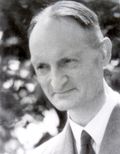

|
|
|
|
|
|
left wall, row 15 #03
.jpg/120px-Valkenburg_aan_de_Geul-Provinciaal_Verzetsmonument_op_de_Cauberg_(12).jpg)
Limburg 1940-1945,
Main Menu
The fallen resistance people in Limburg
pers.Valkenburg 1940-1945
Karel van Berckel
( Karel Clemens)
∗ 19-08-1892 Delft † 05-09-1944 Kamp Vught (52)
- Aid to People in Hiding L.O. - Knokploegen (K.P.) - Heerlen - Underground Press -
- Nationaal Monument Kamp Vught
1. biogr. Karel van Berckel (Nederlands)
2. Website • Nederlands • Deutsch • English • Français - Dr. F. Cammaert, Het Verborgen Front – Geschiedenis van de georganiseerde illegaliteit in de provincie Limburg tijdens de Tweede Wereldoorlog. Doctorale scriptie 1994, Groningen
4. Hulpverlening aan geallieerde piloten en hun bemanningsleden, p.241. Charlotte van Berckel: p.333
11. Illegale pers III.3. Het Vrije Volk, p. 1076 - Het Grote Gebod I-2, De Landelijke KnokPloegen
Limburg, J.W. Hofwijk - Dolle Dinsdag, Wikipedia • Nederlands • Deutsch • English • Français
- 1. Deppner-executies / Erich Deppner, Wikipedia • Nederlands • Deutsch
2. Lodewijck Ivo Crijns, Met Godsvertrouwen voor het vuurpeloton • Karel van Berckel, verzetsman en chirurg, ISBN 9789462490888 - Asputten Kamp Vught
- Plaquette Dr. van Berckel, hospitaal Heerlen
- Erelijst 1940-1945
- Oorlogsgravenstichting.nl
- https://www.nmkampvught.nl/biografieen/1125/
- More in our story Resistance in Valkenburg
- Wikipedia NL: Karel Clemens van Berckel
Detailed information about the surgeon Karel van Berckel [1.1] can be found on the website of the National Memorial Camp Vught [1.2], where he was murdered. The following is an excerpt from it, unless otherwise indicated, including (colored yellow) some quotations:
He attended in Delft elementary and secondary school, then medical studies in Amsterdam..
Some years as assistant in Amsterdam, then one year in Vienna and one year in Paris. Then some years of practice in Amsterdam until his appointment, around 1930, as chief physician at St. Jozef Hospital in Heerlen.
The St. Jozef Hospital on the Putgraaf was at that time still on the outskirts of Heerlen.
He met the fire chief Charles Bongaerts, who introduced him to the resistance in Heerlen. [2.4]
Dr. Van Berckel was already preparing his resistance before the outbreak of the war, among other things by arranging a secret room in his house.
He and his wife Eleonora have systematically obstructed the Nazis since the beginning of the war by offering help to Jews and accommodating crashed allied pilots. Moreover, he wrote for the Heerlen resistance paper Het Vrije Volk, The Free People. [2.11]
Like almost all people of the Limburg L.O./K.P. he was a devout Christian
Van Berckel was one of those who made the hospital an indispensable place for the resistance in Heerlen and the surrounding area. The nuns (Kleine Zusters van de Hl. Joseph) who worked there and ran the place also played an important role.
When messenger of the resistance Theo Crijns was wounded when fleeing and was brought to the hospital as a prisoner, Van Berckel dressed his wounded face in such a way, that he could not speak and managed to keep him out of the hands of the Sicherheitspolizei (German security police) for the time being. Crijns is freed with a shooting, as a result of which a guard died. Dr. Van Berckel ensured that the crew of liberators could leave the hospital with their seriously injured.
In Het Grote Gebod, it says about him: Also: Physicians Resistance. Arrested on August 25, 1944 in connection with the arrest of his daughter at the Spanish border. [3].
This is incomplete. His daughter Charlotte, who studied law in Nijmegen, participated in the student resistance, helped Jewish children and other persecuted people, took on courier services and accompanied refugees to Perpignan. Father and daughter worked closely together. For the border crossing into Belgium, Charlotte employed the services of Franciscan priest J.H. Everts from the Hoogcruts-Slenaken convent.
She and her companions were subjected to a strict check on the train before Perpignan and arrested on arrival. Charlotte was sent to the women’s concentration camp at Ravensbrück but survived the war. [2.4]
On the same page, Cammaert writes: In short, there were enough clues pointing in his direction, but the real reason for his arrest could not be ascertained.
He was interrogated and later arrested, in the early morning of Friday, August 24, and taken to camp Vught. He was murdered on September 5, 1944, on Dolle Dinsdag (Mad Tuesday [4]) with many other resistance people in Camp Vught (Deppner executions [5]) and cremated on the spot. His final resting place is in the ash pits behind the crematorium. [6], only a few days before the Allies freed the camp.
To honor this patriot of the best kind, shortly after the war, on 5 September 1947, a memorial plaque made by the young artist Harry Stump from Heerlen was unveiled in the Saint Joseph Hospital by his wife, which depicts Dr. van Berckel.
Some time after the move in 1968, the memorial stone was placed in the large hall of the new De Wever hospital (now called the Zuyderland hospital) on Henri Dunantstraat. [7]
Karel Clemens ( Karel ) van Berckel is listed in the Erelijst 1940-1945 (Honor Roll of the Dutch Parliament). [8]
Vught • Fusilladeplaats • Former execution site • Ancien site d’exécution
Footnotes
